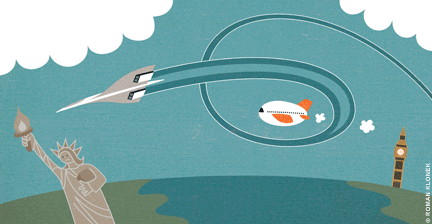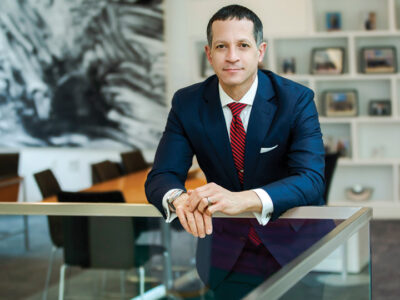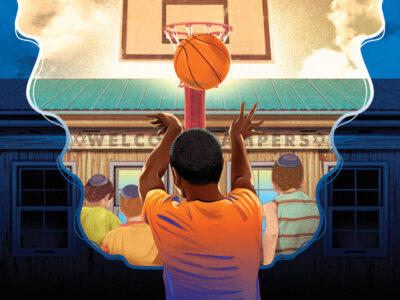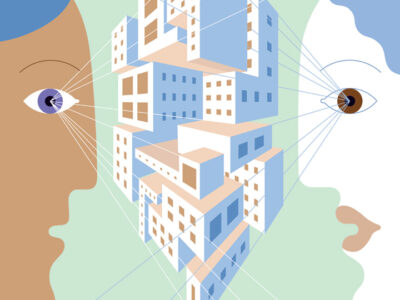
Flying high—and fast—with Mick and the gang on the Concorde.
By Kenneth Rose | I had just taken the first bite of a bologna sandwich (on rye with mustard) when the telephone rang. It was one of those calls that happen once in a lifetime. No, it wasn’t the Rhodes Scholarship Selection Committee handing over a coveted fellowship or the Yankees informing me that I was their top draft pick. It was a courier company. The voice on the other end of the phone informed me, in a very guttural Brooklyn patois, that she desperately needed someone to fly from JFK to London in six hours and, as a “thank you” for my immediate decision to go, I would be returning on the Concorde—for free.
The year was 1984. I had graduated from Penn two years earlier with a degree in political science, and I was to begin medical school in two months. I had been spending my days performing research at New York Hospital and selling imported cheese at a local gourmet shop. The telephone call reminded me of my all-but-forgotten registration to fly as a courier for an air delivery company. At the time, this was a way for the under-funded average Joe to travel to exotic locales for little or no money. To benefit, however, one had to have a very flexible schedule and frequently needed to be available at a moment’s notice. Because FedEx did not yet exist, couriers hand-delivered important documents that could not be shipped via normal mail or air cargo. Ironically, the primitive information technology of the day (fax machines were scarce and email was a decade away from general use) permitted me to sample the finest technology that commercial aviation had to offer.
I quickly accepted.
That night, after an interminable subway ride to the courier office located on the perimeter of JFK airport, I flew six hours to London on a normal commercial flight. I was to spend a week there before returning to New York. Upon arrival at Heathrow, the company relieved me of my courier duties until it was time to return home with a new set of packages. Normally a sojourn in the British capital is a highlight of most European excursions. However my time there is still a hazy blur. Of course, I visited the usual tourist hot spots: the Tower of London, Buckingham Palace, the British Museum, but I could not keep my mind from thinking about the trip home. I would soon be joining the ranks of astronauts, military pilots, and a precious wealthy few, who had the privilege of traveling faster than a rifle bullet. It was not just the speed of the flight that seemed so exciting. Test pilots and astronauts do not usually cross the sound barrier sipping 100-year-old brandy.
The day of my dream flight finally arrived. After an adrenaline-fueled, sleepless night, I arrived at the tiny courier office at Heathrow a good four hours early for my trip. The extra time was not for security purposes—after all, this was 1984—I simply did not want to take a chance on missing my flight. As I waited and pretended to absorb the book I was reading, the secretaries in the office shot me quizzical glances as to why I was there, invading their space, so far ahead of time. I could see the relief on their faces when I was finally taken to the terminal. It was time.
Upon entry into the Concorde lounge, one was relieved of all possessions. Coats, suitcases, etc., would be returned at the arrival gate. Outside the window was the airplane itself. It sat gleaming in the early evening sunshine and appeared impossibly fast even though it was sitting perfectly still. I scanned the extremely well-dressed crowd, of whom I was clearly the youngest member. Most were nestled in expensive-looking leather armchairs reading newspapers and sipping champagne. Surprisingly to me, everyone seemed quite blasé about the adventure that we would soon be taking together. I certainly could not pull that off and paced expectantly around the room. While at the lounge, I recognized Mick Jagger and David Frost (who I believe took more Concorde flights than anyone; he was once quoted as estimating the number as being between 300 and 500). When Sir Mick and I made eye contact, he shot me a friendly wink. At that moment I remember thinking how surreal this all seemed.
Because I was a courier, and not officially paying the circa 1984 $4,000 one-way fare, I boarded the airplane last. As I approached the door, everyone was already strapped into their seats. Upon entering, what was most striking was the petite size of the plane’s interior. Despite standing a mere five feet, nine inches tall, I found that my head almost reached the ceiling. The center aisle was so narrow that it was virtually impossible for two people to pass. When I reached my seat, my seatmate—a Merrill Lynch vice president, who happened to be a 1950s Penn alumnus—greeted me with a handshake and asked me for my name. He, a Concorde regular, explained that when you “sit this close to someone, you either have to know their first name or marry them.” Even by the “cattle car” seating standards present on most of today’s commercial flights, the Concorde was still far from luxurious. Indeed, I could barely squeeze into my seat and had virtually no space between me and my new neighbor. I suppose if this was to have been a normal seven- or eight-hour transatlantic flight I might have been more upset about the close quarters, but not that day.
Moments after boarding, the flight attendants closed the doors and the airplane nimbly made its way toward the active runway. As the pilots revved up the engines to full power and released the brakes, I was thrown backward into my seat. Unlike most planes, which gradually rise into the air, the Concorde shot off the ground like a ballistic missile. The climb and the crossing of the sound barrier (indicated by the “Mach Meter” inside the cabin) was completely uneventful. No sound or vibration was perceptible. After a short time, I noticed that the cabin temperature had increased dramatically. The walls and windows were now quite warm to the touch. Beads of sweat were forming on the brows of both the crew and the passengers. At twice the speed of sound, air friction outside had heated the aircraft’s skin to near the boiling point of water. Peering outside through the tiny window, which was about the size of my hand, from our cruising altitude of 53,000 feet, the sky was a dark blue—we were flying close to the edge of space. The glowing curvature of the Earth could be easily observed from this vantage point. It was a magnificent sight.
For the next three hours, the expert, but profusely perspiring, cabin crew served us a sumptuous five-course meal, which included Homard, Sauce maltaise, and Suprême de poussin grillé, finished off with vintage port wine and the finest Jamaican cigars (smoking was permitted throughout the cabin in those days). During dinner, my neighbor, having availed himself of virtually every variety of alcoholic beverage presented to him, became quite inebriated, cheerfully regaling me with ribald tales of debauchery from his fraternity days at Penn. Fortunately, he was a happy drunk—and his rambling stories convinced me that little had changed on campus in 30 years.
At the midway point across the Atlantic, the pilot informed us that we would soon be gaining on the airline’s regular subsonic flight to New York, which had left London four hours ahead of us. As I looked down 20,000 feet, we streaked passed the lumbering jumbo jet as if it was standing still. Otherwise, without such reference points, one had no perception of flying 1,340 miles per hour.
All too soon we were descending toward JFK airport and the end of my aviation fantasy. The landing was gentle and uneventful, except that you had the impression that everyone at the airport was staring at you. The entire transatlantic crossing took three hours and 30 minutes. (The exact same aircraft I was flying that day holds the record for the fastest commercial crossing of the North Atlantic. It was recorded at two hours, 52 minutes, and 59 seconds on Feburary 7, 1996.)
Retrospectively, in practical terms, the lack of physical comfort was not worth the price. Flying transatlantic in a first-class sleeper seat for the same fare seems much more cost-effective and enjoyable—if, that is, one were paying for it.
Of course this is a moot point, as the Concorde is now a piece of aviation history, done in by the lingering effects of a crash in 2000 that killed more than 100 people and finally by 9/11’s impact on the travel industry. The last Concorde flight was in late 2003, and the actual plane in which I flew sits forever mothballed on a barge in the Hudson River as part of the Intrepid Sea, Air, and Space Museum.
When we arrived at the gate, the mighty engines were shut down. Mr. Frost, Mick (who had been sitting directly in front of me), the well-liquored Merrill Lynch VP and the rest of the passengers rushed for the exit door. One day, I thought, they all would probably get the chance to return for another flight on the Concorde. I, however, stayed behind until the aircraft was completely empty, wanting to savor every last moment of this flight.
As I sat alone in the deserted airplane, I realized that I had just experienced something truly rare and special. Sometimes life hands you beautiful and unexpected gifts, and one must be willing to take them. After a short time, I reluctantly got up to leave. The subway was waiting. I hoped it would not take three hours and 30 minutes to get home.
Kenneth Rose C’82 is a plastic surgeon in Manhattan and is married to Jayne Ressler C’89 W’89 L’94.




